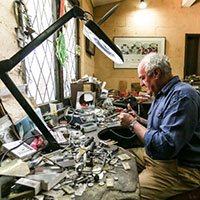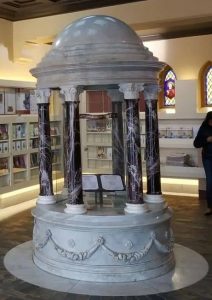 St Francis’ Church, Lonsdsale St, Melbourne
St Francis’ Church, Lonsdsale St, Melbourne
In 1978, the two brothers, Dan Flynn BArch and John Flynn BSc, followed their father, also Dan Flynn, as silversmiths in a family business based in Kyneton, central Victoria. Their extensive array of ecclesiastical work began in 1947 when their father designed a chalice for his brother Leo, a Jesuit, to use at his ordination.

Brothers Dan and John in their workshop at Flynn Silver
Since that time, Flynn Silver has established a national and international reputation for exquisite designs in silver and gold. A member of the distinguished London Goldsmiths Hall and the Australia Gold and Silversmith Guild, Flynn Silver’s designs adorn rooms in the Vatican, Buckingham Palace, and the White House, and are prized by corporations including Ferrari, Qantas, BHP Billiton and ANZ.
Flynn Silver has been commissioned to produced gifts and trophies for the Commonwealth Games and the Formula One World Championships, plus architectural designs for private homes. Their ecclesiastical work graces Church communities throughout Australia, including St Francis’ Church, Lonsdale Street Melbourne, St Mary’s Cathedral in Perth, Xavier College Chapel and the Carmelite Monastery Chapel, both in Kew, VIC.

The set of eucharistic chalices and bowls that were commissioned by the community of St Francis’ Church in Melbourne around the year 2001 were intended to coincide with renovations to the sanctuary and the provision of a new marble Mass altar. The generously proportioned chalices in particular were deliberately commissioned in order to provide communion under both kinds for the people at Mass, a rich expression of their full, conscious and active participation in the Eucharist (Vatican II, SC 14). The chalices feature three stems joining the base and the cup. The design was based on an inversion of the tempietto structure that used to sit on top of the high altar to enshrine the monstrance containing the Blessed Sacrament during periods of exposition; it has since been relocated to the church porch to enshrine other focal points for prayer, such as a remembrance book during the month of November.
Sacred vessels, St Francis Church, Melbourne

The commissioning of the chalices and communion bowls is very much in keeping with the eucharistic apostolate of members of the Congregation of the Blessed Sacrament who staff St Francis’. The clergy have (until the COVID-19 pandemic) normally provided communion under both kinds at every Mass each week (approximately thirty Masses). This hospitable gesture is provided for by the Church’s conciliar liturgical norms (SC 55, GIRM 281) and is a response to Christ’s command to ‘take and eat’ and ‘take and drink’ in his memory (See Mt 26:20-29, Mk 14:17-25, Lk 22:14-20 and 1 Cor. 11: 23-25). Communion under both kinds provides a more significant expression of participation in the Lord’s sacramental banquet than communion under the form of the consecrated bread alone.
It is especially fitting that a precious, noble metal such as silver is used to hold the precious Body and Blood of Christ. Traditionally associated with ‘divine wisdom’, its use suggests that we offer ‘our best’ to God during the Eucharistic sacrifice. The reintroduction of the communion cup for the laity after the Second Vatican Council is associated with Jesus’ offering and sharing the biblical ‘cup of suffering’ at the Last Supper, a gesture that pre-figured the offering of his life-blood for the salvation of the world on Good Friday. Drinking from the cup implies Christian discipleship with the Lord.
There is also a future dimension: drinking from the cup of salvation and celebration prefigures our destiny as members of Christ’s body. Communion from the chalice provide a foretaste of our full communion with God the Father, Son and Holy Spirit and the entire choir of angels and saints at the eschatological banquet in the heavenly kingdom (GIRM 281).
The pastoral provision of communion from the cup in one of Australia’s busiest Mass centres is a very generous gesture and requires considerable preparation before, during and after Mass by clergy and servers, ministers of Holy Communion and sacristans. A unified set of vessels makes good aesthetic sense, as it does when using sets of crockery and cutlery during formal meals in other contexts. However, more than this, the set of silver chalices and bowls underscores the importance of dignified eucharistic hospitality and helps the Communion Rite look unified. The use of a set of vessels also honours the values enshrined in the ACBC’s And When Churches are to Be Built (2014) which says every part of the sacred building must make its own unique contribution to the unity of the whole (106).
How appropriate that a firm renowned for the production of wonderful gifts and trophies should produce these beautiful eucharistic vessels: they are a reminder of St Paul’s image in Romans (14:7-12) of the Christian community, a group of earthen vessels, striving to attain the gift of Christ who has already captured them and gained for them an eternal reward.
Dr Paul Taylor is executive secretary of the Bishops’ Commission for Liturgy.
